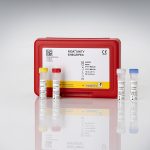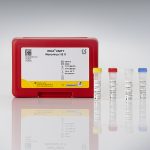Intended use:
For in vitro diagnostic use. The RIDA®GENE Pediatric Viral Panel test, performed on the LightCycler® 480 II real-time PCR instrument, is a multiplex real-time RT-PCR for the direct qualitative detection and differentiation of rhinovirus/ enterovirus/ parechovirus RNA, bocavirus DNA, and adenovirus DNA in untreated human nasal/throat swabs from people with signs and symptoms of a respiratory infection.
The RIDA®GENE Pediatric Viral Panel test is intended to support the differential diagnosis of rhinovirus/enterovirus/parechovirus, bocavirus, and adenovirus infections in patients with symptoms of a respiratory infection in connection with other clinical and laboratory findings.
Negative results do not rule out infection with rhinovirus/enterovirus/parechovirus, bocavirus, or adenovirus and should not be used as the sole basis for diagnosis.
The product is intended for professional use.
General information:
Viral respiratory tract infections are one of the primary causes of hospitalizations and clinic visits in children and older people. In addition to the known respiratory viruses like influenza and SARS-CoV-2, adenoviruses, bocaviruses, enteroviruses, parechoviruses, and rhinoviruses can cause respiratory tract infections.
Human adenoviruses (HAdVs) belong to the family Adenoviridae and the genus Mastadenovirus. They are icosahedron-shaped, nonenveloped, double-stranded DNA viruses with a diameter of 65 to 110 nm. They are divided into seven species, (A to G), which comprise about 67 serotypes.
Human bocaviruses (HBoVs) are icosahedral, small, nonenveloped parvoviruses. They are about 18 nm to 26 nm in diameter and have single-stranded DNA with a genome size of 4 kb to 6 kb (plus terminal sequences of 32 to 52 nucleotides). The role of HBoVs as harmless passengers is still contentiously debated because they are often isolated in combination with other pathogens. HBoVs comprise four subtypes: HBoV1, HBoV2, HBoV3, and HBoV4.
Enteroviruses and rhinoviruses are single-stranded, icosahedral, nonenveloped RNA viruses that have a genome size of about 7.2 kb. Before molecular tools were introduced to classify pathogens, rhinoviruses and enteroviruses were considered to be two very different pathogens. Today, we know that they are genetically related to one another. They both belong to the genus Enterovirus within the family Picornaviridae. Human enteroviruses (HEVs) comprise four species, HEV-A, HEV-B, HEV-C, and HEV-D, with more than 200 different serotypes. Rhinoviruses are divided into three species, rhinovirus A, rhinovirus B, and rhinovirus C, which comprise about 150 different types. Like enteroviruses and rhinoviruses, human parechoviruses (HPeVs) belong to the family Picornaviridae, but they are classified under the genus Parechovirus. HPeVs are single-stranded, nonenveloped RNA viruses. HPeVs comprise 19 genotypes (HPeV1 to HPeV19), whereas HPeV1 and HPeV3 are the most common.
HAdV infections that affect the respiratory tracts are reported with common cold-like symptoms including fever, sore throat, vomiting, and diarrhea, and severe infections are reported with conjunctivitis and lung inflammation. HBoV infections induce wheezing and cough as common symptoms. Both viruses are distributed worldwide and occur throughout the year, whereas HBoV reaches a peak in the winter and spring months.
Reported symptoms of HEV respiratory tract infections include cough, shortness of breath, wheezing, and fever. HEV infections are more common in the summer and fall in temperate climates and occur throughout the year in tropical regions. Rhinoviruses are distributed worldwide, with higher prevalence in spring and fall. They occur commonly in patients with pneumonia, bronchiolitis, or an infection of the middle ear and can occur with or without copathogens. Rhinoviruses cause symptoms like rhinorrhea, sore throat, cough, headache, nasal congestion, and malaise. Common symptoms of an HPeV infection are common cold symptoms such as stuffy nose and fever as well as cough.
Usually viral respiratory infections with these viruses are self limiting or asymptomatic, but especially children, older people, and patients with immunodeficiency can be affected by a severe disease.
Accessories:
| Art. No. | PG4725 |
|---|---|
| Test format | real-time PCR with 100 reactions |
| Shelf life | 24 months after productions |
| Sensitivity | ≥ 50 copies / reaction |
Dear customers,
we have started to provide the documents for our products in an electronic format. These are the Instructions for Use (IFU), the Safety Data Sheets (SDS) and the Certificate of Analysis (CoA). For batches placed on the market after 01 January 2023, you can find our documents on the eIFU portal eifu.r-biopharm.com/clinic.










